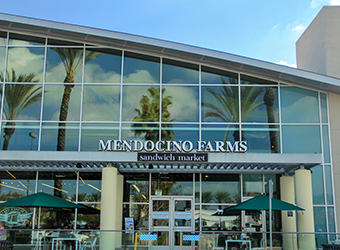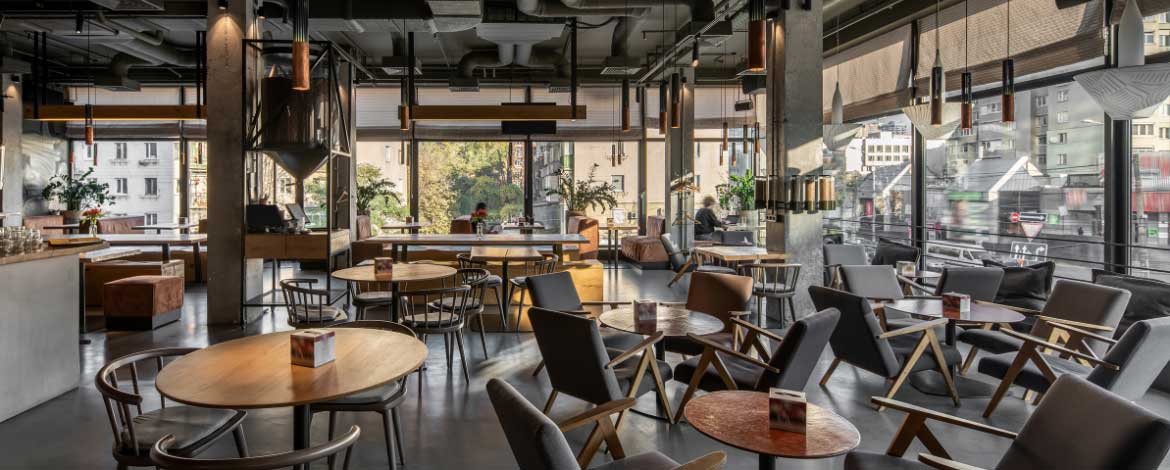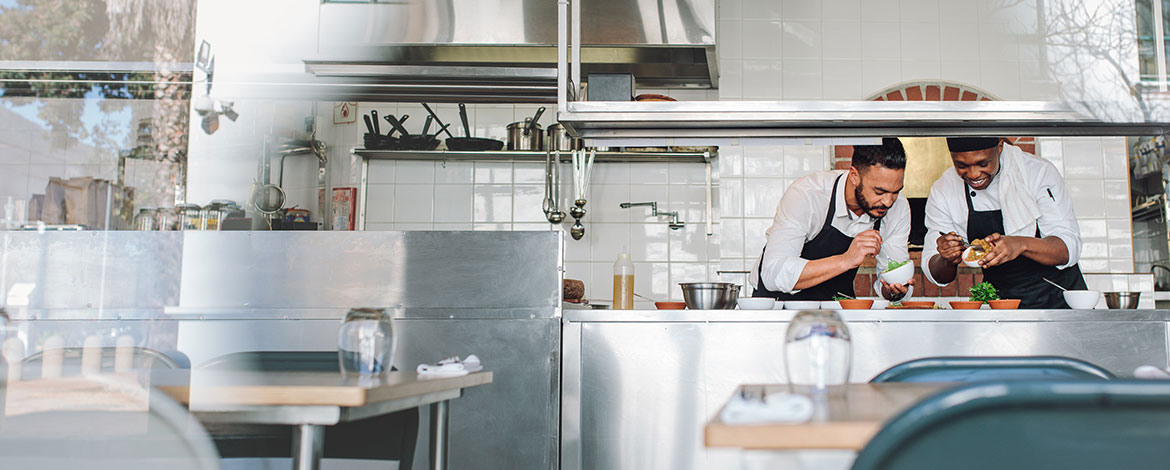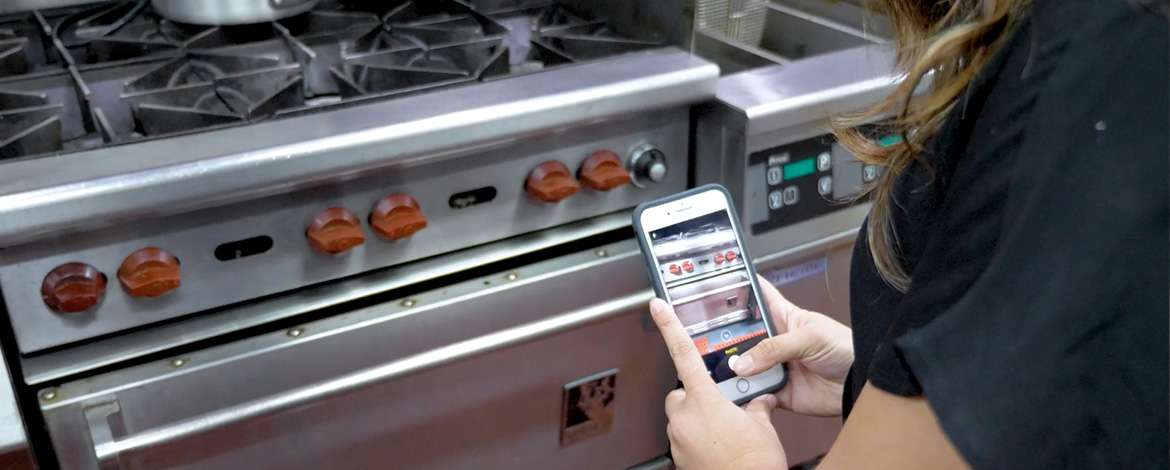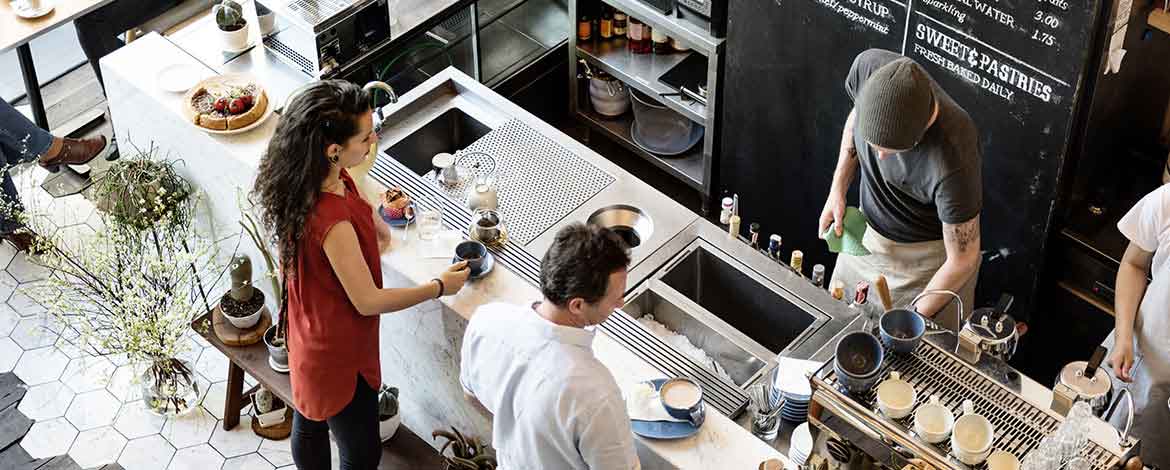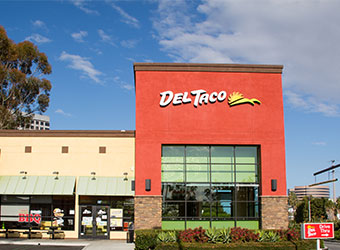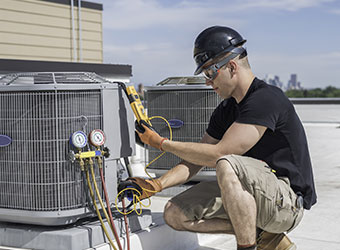Welcome to the future of facility management! As a dedicated facility manager, you know that staying ahead of the curve is key to success. In the digital age, embracing automation and AI is no longer a luxury – it's a necessity. Let's explore how integrating advanced technologies like CMMS platforms, IoT sensors, and robots can revolutionize your facility management practices and take them to new heights.
Embrace the Power of CMMS Platforms
Streamlined Workflows: Bid farewell to manual processes and paperwork. With a robust CMMS platform, you can digitize work orders, track maintenance schedules, and manage assets effortlessly. Save time and stay organized.
Data-Driven Insights: CMMS platforms offer valuable data insights to make informed decisions. Leverage real-time reports and trends to optimize maintenance strategies and boost efficiency.
Optimized Resource Allocation: Allocate resources smartly with predictive maintenance capabilities. Identify potential issues before they escalate, saving costs and minimizing downtime.
Harness the Potential of IoT Sensors
Real-Time Monitoring: Equip your facility with IoT sensors to monitor critical systems in real-time. You'll have a comprehensive view of your facility's performance from temperature and humidity to energy usage.
Proactive Maintenance: Detect anomalies early and address them proactively. IoT sensors can identify equipment issues, preventing breakdowns and costly repairs.
Enhanced Safety: Create a safer environment with IoT sensors that monitor hazardous areas and alert your team to potential risks. Safety first, always!

Embrace the Robot Revolution
Efficient Cleaning and Maintenance: Robots can take over repetitive tasks like cleaning and maintenance, freeing up your team for more strategic projects.
24/7 Operations: Some robots can work around the clock, ensuring continuous monitoring and efficient operations, even during off-hours.
Augmented Workforce: Robots and humans make a powerful team. Embrace robots as valuable allies that complement your team's skills and enhance productivity.

Overcoming Challenges and Embracing Change
Training and Adoption: Empower your team with training on the new technologies. Address any concerns they might have and highlight the benefits of automation and AI.
Data Security and Integration: Ensure robust data security protocols when implementing new technologies. Also, focus on seamless integration with your existing systems for smooth operations.
Flexibility and Scalability: Choose technologies that can adapt to your facility's evolving needs and accommodate future growth.
Conclusion
The digital age presents a sea of opportunities for facility managers to excel. By embracing automation and AI through CMMS platforms, IoT sensors, and robots, you'll not only streamline operations but also enhance efficiency, safety, and resource allocation. Embrace the future with open arms, and witness your facility management practices soar to unprecedented heights.
INDUSTRY INSIGHT
What's Happening at Ecotrak
Today she’s the Executive Director and CEO of the Restaurant Facility Management Association, but this mosaic-loving, former graphics designer in the oil business and grandmother of two has forged a fascinating, circuitous path to get here. We sat down with Debi Kensell, Executive Director & CEO of the Restaurant Facility Management Association (RFMA) to reflect on her career path and current leadership role at RFMA. Read the full interview below.
Tell us about RFMA and your current role.
RFMA was established in 2004 by a group of restaurateurs that believed there was a unique need of education in restaurant facilities to warrant a standalone association. RFMA was created to do just that, educate, and provide opportunities for members to build relationships with industry partners coming together to network about facilities and vendor needs.
What are the mission and goals of RFMA?
Our mission is to equip restaurant facility professionals to advance their careers and organizations. Our goal is primarily to elevate their status within their companies and within their industry peers. When I started in the association world of facilities there were very few high-level positions within the facilities departments. Today we see VP’s of facilities throughout our restaurant member companies.
How many members does RFMA have?
Over 1450 individual members representing over 250 restaurant brands; we have over 400 vendor companies.
What are some of the benefits of being a RFMA member?
The biggest benefit is building your restaurant facilities network when you join the RFMA family. Members receive free education through webinars and the CRFP Prep Course as well as discounted rates for the CRFP exam and meeting registrations. Each member receives the Facilitator, the official association magazine. We have a weekly newsletter called the Dish to keep members aware of upcoming events and opportunities. As a member they can look up members in areas all across the United States, whether they need a service provider or a peer to discuss needs in a certain region. Our restaurant members always say we’re not trading recipes, just trying to keep our stores up and running, our network helps with that.
What was the path you took to get to where you are today?
Association Management is my second career. I worked in the oil industry for 20 years doing geological mapping of seismic data for Conoco, Diamond Shamrock, and Maxus Energy. While working at Maxus in the late 90’s the company was bought out and the Dallas office was closed. One of my coworkers was helping her brother and several retailers start an association and because of my volunteer work at Maxus for the United Way campaign and the annual golf tournament, she asked me to come on as their meeting planner. I joined Meeting Planners International and began taking all offered curriculum to enhance my meeting planning skills. During my tenure at PRSM, now known as Connex, I was the regional meeting planner and moved into Education in 2003. I joined RFMA in 2008 as the Membership and Education Manager and then became the Education Director in 2010, then after a couple of leadership changes was promoted to Executive Director in September of 2021.
What has been the proudest moment in your career?
I have always been validated by the success of my contributions at each entity, but my proudest moment was when the RFMA Board of Directors put their trust and faith in me to lead the association through my role as Executive Director & CEO. RFMA is one of the best organizations I’ve ever been associated with, and our staff team is one of the best in the industry. Having their respect and support has been invaluable in this new role.
Who has inspired you as a leader?
I had the privilege of working with Tracy Tomson, RFMA’s Executive Director from inception through 2020. I never felt like I worked for Tracy, she had the ability to make everyone feel like they were the most important person on the team while not favoring any of us over the other. She also volunteered for many organizations while running RFMA and raising 3 daughters. She’s a special individual and we remain friends today. I use many skills I learned from working with her to manage RFMA today.
What do you feel is the biggest strength of RFMA right now? Any challenges?
Hands down the culture our members and leadership have created. It really feels like a family reunion when we’re onsite at our conference each year. Our biggest challenge is the ever-changing workspace and economy. We always say our biggest competitor is our member’s time. We put a lot of energy into our conference to make it worthwhile for them to be out of the office.
Tell us about the RFMA conference 2023
We are very excited about our RFMA 2023 conference. The exhibit hall is close to being sold out. Registration for attendees will go live on November 1. We have secured our Keynotes and Signature Speakers and are working to develop curriculum for the breakout sessions. We are in the planning stage for the opening and closing parties, but I promise San Antonio will be a fun host city that will provide lots of time for networking and education.
Is RFMA launching anything new this year for the 2023 conference that we should be aware of?
We have several programs launching this month.
• RFMA kicked off our new Partner Program for our vendor members. The Partner Program is an opportunity for year-round exposure and additional conference exposure for vendor members. Partners receive the exclusive RFMA Partner logo along with extensive benefits at the conference AND all year long. We will be looking for a Leadership RFMA Partner, a CRFP Partner, and a Females in Facilities Partner next!
• We also have an ambassador program for all first-time exhibitors the Vendor Communication Task force has developed. They will meet with first-time exhibitors leading into the RFMA conference on topics such as maximizing the vendor membership, conference schedule review, logistics for show, express exchange, and post-conference conversations. This program is to ensure that all first-time exhibitors have a successful first-year/conference experience. Our goal is that this will lead to developing more sponsors and partners over time.
• During the 2023 Annual Conference we will have the Conference Connect Café which will allow first-time attendees an opportunity to socialize and feel “welcomed” at RFMA 2023. First-time attendees will be matched with a guide prior to the conference. During the event, attendees will have the opportunity to: socialize with their “guide”, meet other first-time attendees, and ask questions about the Conference.
What was your favorite RFMA Conference to date? Do you have a favorite city to host?
My favorite conference was bittersweet. We created a really gorgeous setting for RFMA 2020 and a big send-off for our retiring Executive Director, Tracy Tomson. The day we were traveling to the event cancellations started due to COVID-19. It was an amazing event, but unfortunately, about 250 attendees had to cancel due to travel restrictions and a few of our exhibitors. It was still a great event, and we were very fortunate to be able to execute it. We were the last conference at the Gaylord Rockies during the shutdown. We are doing the Rockies in 2026 and hope all the people that missed 2020 will be able to attend then. Favorite city to host? Nashville was amazing this year. Our attendees seemed to really love the city and venues connected with the conference.
Outside of the RFMA Conference, RFMA holds additional round table meetings, events and opportunities to get involved in some great causes, can you tell us a little more?
We have some really great events starting this month. Please check out the RFMA events page at www.rfmaonline.com to register for anything upcoming. My favorite event each year is our RFMA Gives Volunteer Day. This year were in San Marcos, Texas at the Southside Community Center. We had over 150 volunteers onsite. It was a wonderful day spent with our members improving the Community Center and Retirement Homes so they can better support the community. We do this every year in the city we are hosting our conference. Unfortunately, San Antonio did not have a perfect match for what we do so we chose San Marcos thirty minutes north of the city.
What are some of your interests outside of RFMA?
I have two grandchildren that I love spending time with, I love to get to the beach when I can, and I am a mosaic and stained-glass hobbyist.
Anything additional you’d like to share with us?
Just that I would encourage anyone in the industry who is not yet a RFMA member to join. We really are here as a resource to help you be more successful in your career and for you personally. The friendships I’ve made through RFMA over the past 14+ years mean the world to me. I’m looking forward to seeing many of them in San Antonio, March 19 – 21, 2023.
INDUSTRY INSIGHT
What's Happening at Ecotrak
For some, going to a restaurant is all about the food. For others, the excitement is tied to the experience. If the place has a gimmick, a mini-golf course out back or a waitstaff that belts out showtunes, that just makes the appetizers all the more appetizing.
For us, the sweet spot is somewhere in the middle. While great food engages your eyes, nose, tastebuds and stomach, eating it in a standout environment stimulates your mind and soul as well. All in all, it’s the perfect meal — and it looks way cooler on Instagram.
With that in mind, below are a list of amazing restaurants from coast to coast that will get your mouth watering, your anticipation building, and make you feel like you’ve found the perfect intersection of setting and sustenance. What do the restaurants on this list all have in common other than a killer vibe and delicious food? Answer: They are managing their restaurant facilities with Ecotrak. Check out 13 of our most Instagramable restaurants. How many have you visited?
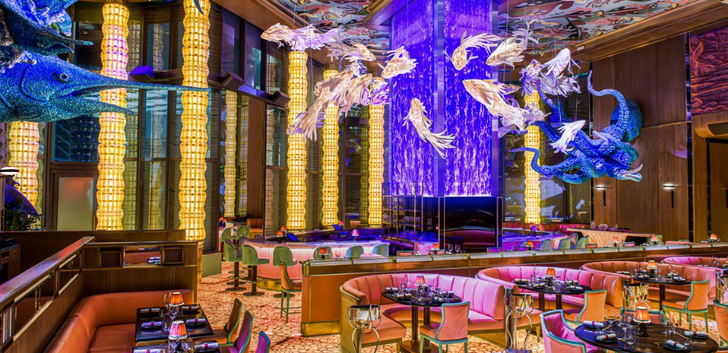
Sexy Fish (Miami)
The motto of this Florida hot spot is “looks as good as it tastes,” and you’d be hard pressed to find food as visually appealing as their Crispy Duck & Watermelon salad with pomegranate, Golden Fish & Crispy Caviar, Beef Tartare with Perigon Truffle or Busby Berkeley-like arrangements of sashimi, gyoza and tempura for days. Surrender yourself to the allure of the omakase, and Sexy Fish’s highly-trained chefs will leave you walking on air.
But if you can turn your gaze away from the table long enough, you’ll be captivated by what has been called “Miami’s most opulent dining room,” fueled with eye-popping artwork by artist Damien Hirst, Frank Gehry-designed fish lamps, and interiors designed to evoke ocean motifs and mid-century brasseries.
As the evening begins, order yourself a theatrical cocktail like the “Smoke & Peppercorn” (pink peppercorn-infused mezcal and sancho pepper tequila), the “Raspberry & Yogurt” (a Grey Goose punch) or “Pumpkin & Spice” (pumpkin and chai cordial with gin, served in a coral-inspired glass) and prepare yourself for something even showier. Mermaid dancers bring “Sexy” back alongside famed DJs and other out-of-this-world showstoppers. Plug into the wind and percussion instruments transporting patrons on an underwater musical adventure, and as the champagne and tequila flows, you’ll be hooked.
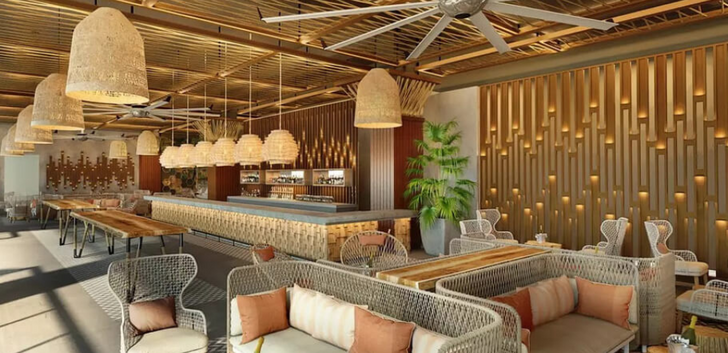
Kassi Beach House (Las Vegas)
In the Gambling Capital of the World, there are so many dining options that it’s easy to get lost. But this Italian coastal alternative, located inside the Virgin Hotels, is no roll of the dice.
The vibe here is the equivalent of attending a celebration at the most amazing beach house you’ve only seen in movies. The dress code is bikinis and trunks, signature punch bowls serve communal cocktails for the table, and it’s all steps from the pool (and reservation-only daybeds), under a disco ball with a thumping musical beat.
The interior is a stunning mix of wood and wicker, boasting huge wraparound booths and walls of ornate ceramics. The daily brunch is a place to see and be seen, as you sip bottomless rose and try a truffle pizza. In the evening, family-style meals, tomahawk steaks and made-in-house pastas are counterbalanced with bottles of wine, negronis and Japanese penicillin.
Imagine yourself and five of your besties, sharing a poolside daybed and sipping Subtropic slushies. What’s the Italian word for paradise?
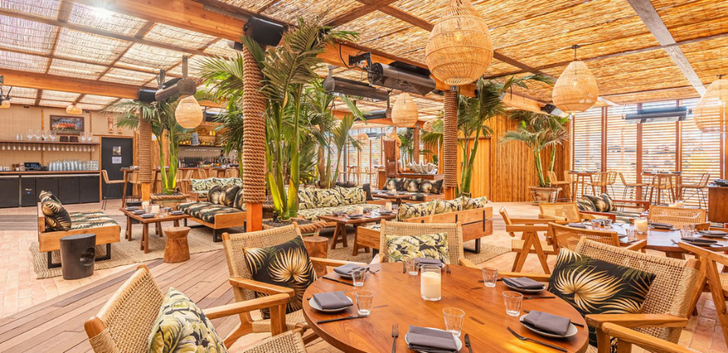
Belles (Venice, CA)
Tiki culture dates all the way back to the 1920s, when South Pacific-tinged dreams of escape first took hold of American culture. Embracing that mindset but stripping away the kitsch, Belles Beach House boasts island vibes and open-wood slats that let a cool breeze blow across one of the best cheeseburgers in town. Then, of course, there are the drinks.
Slip into a flowered booth and sip on a “Heat Stroke” (tequila, passion fruit, mango and smoked cayenne salt), a “Watermelon Mezcal Margarita” or “Seven samurai” (Japanese whiskey, lemon, sour apple, pear and ginger). Feeling social? Get your cocktail of choice in a punch bowl, and watch new friends flock to your table.
Look up from your drink and take note of the one-of-a-kind tiki totem lamps smiling back at you. Thankfully, it isn’t considered impolite to not offer them some of your Lobster Hand Rolls, Butterfly Branzino or Char Siu Pork Ribs with a pineapple glaze. Tiki is a way of life … and sitting in this slice of surfer nirvana, overlooking the Venice Beach boardwalk, another fresh-pressed drink with tequila will get you right where you need to be.
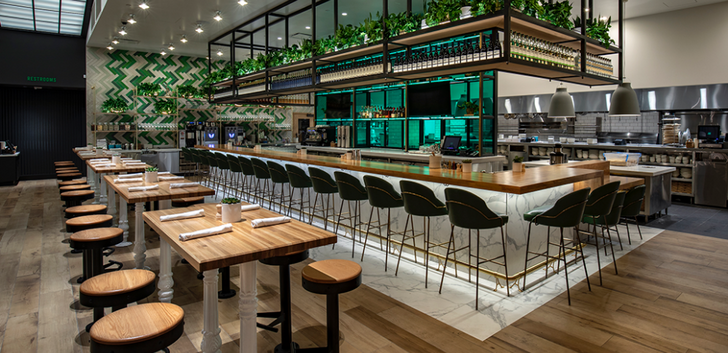
True Food Kitchen (Nationwide)
Employing freshness, seasonality and the principles of Dr. Andrew Weil’s anti-inflammatory diet as its foundations, True Foods has taken a lifestyle once out of reach for most Americans and spread it across 17 states — and growing. Describing their menu as “Fundamentally based on science,” True Food believes that better food leads to better lives, but don’t think such focus on sourcing, sustainability and nutrition robs the food (or their dining rooms) of flavor.
Walking into a True Kitchen, the first thing you notice is that the guests, the dining room and the kitchen have all blended into one ecosystem. It underlines the notion that we’re all on this mission together. The bright, airy restaurant is surrounded by produce and productivity, as culinary experts prepare bright, colorful dishes with potent ingredients like turmeric, broccolini and bok choi. And don’t sleep on the scratch bar, juicing fresh ingredients and preparing syrups for brunch cocktails like the Watermelon Mimosa.
To underline the mentality of a healthy body being in alignment with a healthy mind, True Food Kitchens have been known to offer yoga classes. So stretch your body — and your palate — at a True Food near you.

The Eveleigh (West Hollywood)
The best restaurants are expertly paired with their location, like a great wine and cheese. Look no further than Eveleigh, a country comfort restaurant that opened in its inviting, homey residence about a dozen years ago but feels like it’s been there since the structure was built upon an orchard in 1923. Brunching off the Sunset Strip, as the California sunshine pours through olive tree branches and onto your Dungeness Crab Pasta, you’ll feel perfectly paired as well.
A vine-covered pergola welcomes diners to the outside patio. Indoors, a dining room every bit as bright frames a bartender, working hard on your next favorite cocktail. Whether you want to try a “Negroni Chupacabra” (mezcal, aperitivo, vermouth and prickly pear), “Inbetween Days” (vodka, vermouth, grapefruit, thyme, lemon and soda) or a “Unicorn Juice” slushie, you can’t go wrong.
The Eveleigh really comes to life, however, for large groups gathered around the communal table for 15 (nestled under a retractable, open air roof) or the back patio with a view of the city. Grab some friends, share some sips, and you might find yourselves debating whether The Everleigh is prettier during the day or at night.
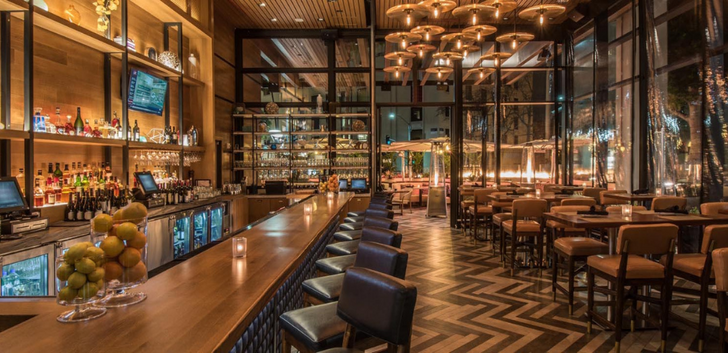
Ocean Prime (Nationwide)
When chef Cameron Mitchell was growing up in Ohio, he used to sit at his mother’s kitchen table and dream of opening elegant fine dining restaurants from coast to coast. Now, his Ocean Prime restaurants are serving up steaks, seafood and cocktails in 18 stunning dining rooms from Beverly Hills to Boston.
Every Ocean Prime feels like its own art gallery, but rather than impressionist paintings on the walls, everyone is oohing and aahing at the Twin Lobster Tails, Colorado Lamb Chops or mouthwatering sides like Black Truffle Mac & Cheese. In Beverly Hills, the massive booths envelop you while you marvel at walls of immaculately-arranged wine bottles. Dallas has smokey slatted windows and a modern outdoor firepit. From the jellyfish-like lamps in Indianapolis to the magnificent coral in Philly, each location seems intent on one-upping the others in opulence.
At the center of it all, however, is Mitchell’s meticulously-orchestrated menu. Taken together, the experience is a spectacle that thrills you from the inside out —it’s enough to make any mother proud.

Katsuya (Nationwide)
Arguably the progenitors of modern art-is-everywhere dining, master sushi chef Katsuya Uechi and design maestro Philippe Starck have spent a decade launching stunning locations from Hollywood to Manhattan. Each is a reflection of its location, from the chill vibes of Brentwood to pulsating South Beach, whose location in SLS South Beach boasts a Tower Penthouse designed by Lenny Kravitz and featuring unique, curated dishes and vintage vinyl.
In New York, diners congregate under Japanese uchiwa fans while devouring Chef Katsuya’s signature Baked Crab Handrolls. In the Bahamas, traditional Japanese cuisine is mixed with California style surrounded by dangling chandeliers and striking art. In Hollywood, servers shout “irashaimase!” before you get to work sipping a “Burning Mandarin” and nibbling on Crispy Rice with Spicy Tuna in their black-and-gold dining room.
Whether sitting in the sushi bar or holding court in a dining room made to see and be seen, Katsuya has spent a decade as the gold standard.
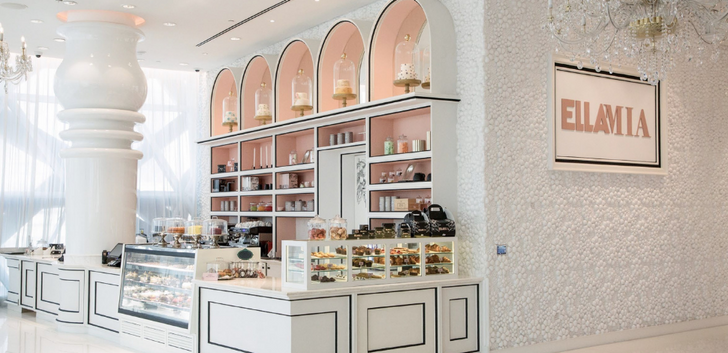
Ella Mia (Worldwide)
To some, coffee is a necessity. To others, it’s a ritual.
Pay your respects to the most sacred of beans in these sophisticated, contemporary spaces that couldn’t be further removed from your grandpa’s coffee shop. Whether you’re in Doha or Dubai, New York or London, you’re bound to have your eyes opened — and not just by the caffeine.
Each EllaMia has a clean, distinctive look marked by brightness and warmth. Glass cases display amazing pastries, including tarts and cakes. Sip on a Rainbow Latte, enjoy it with a slice of Fig & Rose cake, and wonder if this might just be Willie Wonka for grown-ups.
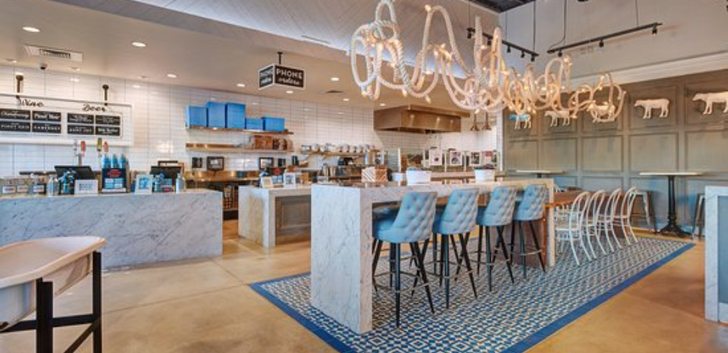
Mendocino Farms (Western US)
When you’re looking for sandwiches, salads and other foodie faves that are fast — but most decidedly not fast food — look for the blue cow.
Since 2005, this rapidly-growing chain (mostly throughout California, now expanding into Texas) has been the go-to for lunchtime treats like the Sweet Heat Crispy Thai Chicken Sandwich, Mrs. Goldfarb’s Unreal Reuben and Pork Belly Banh Mi (with a vegan version, for those so inclined). But the “Soulful Salads,” with ingredients like avocado, quinoa, grape tomatoes, pink lady beets and Impossible chorizo, are delicious enough to make you forget you’re eating so healthy.
If you catch their seasonal specials at the right time, you might be able to snag the delectable Oaxacan Potato Salad or mouthwatering Thai Watermelon & Cucumber Salad. Enjoy it all in a clean, bright dining room with whimsical details like foosball tables, turf-lined seats, and cows on the wall. Most locations also have a children’s play area, so you can enjoy a Chimichurri Steak & Sashito Bowl while your little critters enjoy time on the farm.
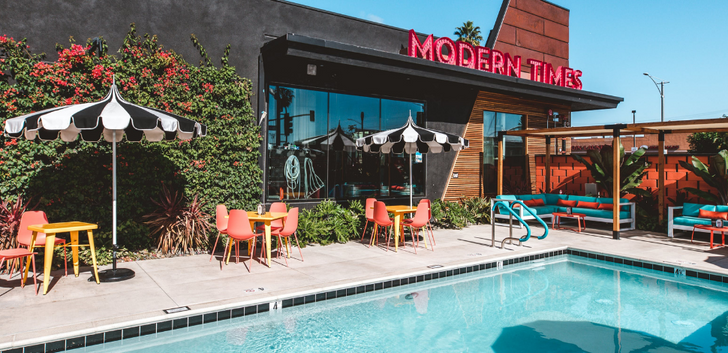
Modern Times Brewery (Anaheim)
The OC’s “Leisuretown” aims to be a permanent block party, and anchoring it all is Modern Times — the collection of brewers, coffee roasters and culinary experts who formed a Justice League-like cadre of flavor in 2013, opening a brewery and tasting room in Point Loma.
This, their fourth location, is also the most off-the-wall. A combination brewery, restaurant, café and swim club, the property is anchored by a serene swimming area whose stated mission is to put visitors “in a dimension of epic and abiding chillness.” Bringing the leisure to Leisuretown, a brightly-colored pop art bar houses 70 brews and ciders on tap, house-roasted coffees and an extensive wine list.
Their 100 percent plant-based menu includes no-brainers like avocado toast and corn fritters, but also outside-the-box dishes like “Fuegolote” (fried corn on the cob with house-made tajin) and the “Munchwrap” (Impossible taco mix, queso and more in a flour tortilla). Swing by their mini-mart for some “sexy merchandise,” order a flight, and find yourself a sun lounger by the pool. Instant glimpses for The Gram.
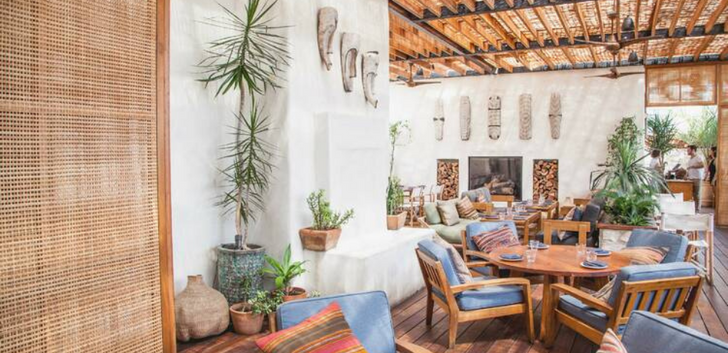
Elephante (Santa Monica)
Who doesn’t dream about owning a beach house, enjoying pitchers of cool drinks and amazing food? Dream no more; just get to Elephante at sunset.
Patrons of this rooftop bar and restaurant enjoy a Southern Mediterranean chill without needing to board a plane. The flavors of Italy inspired hand-crafted cocktails like “The Book Thief” (nosotros respado, cocchi rosa, lime, honey, peach and allspice), “Golden Hour” (bourbon, apple, lemon, vanilla and cinnamon bitters) and a “Coconut Negroni” keep things cool. Enjoy one (or three) with some Polenta & Mushrooms, Diver Scallops or a family-style Veal Milanese for the perfect evening.
The real show here, however, is on par with any band or DJ you could hope to hire. Every evening, the patio is packed with onlookers, watching the one-of-a-kind Southern California sunset into the Pacific Ocean. At Elephante, it’s an experience you’ll never forget.
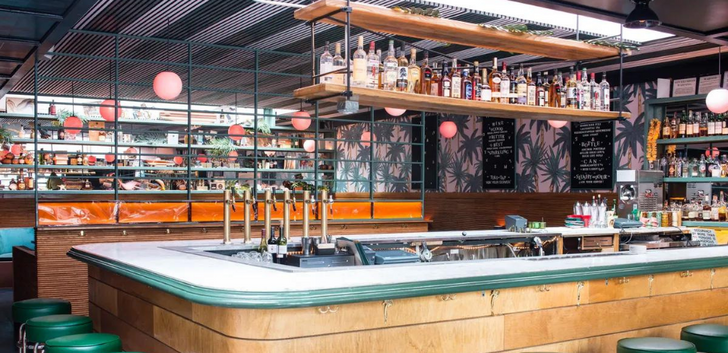
The Happiest Hour (New York)
Cartoon palm trees, flamingo tchotchkes, whimsical drinks, diner-style food and a rock ‘n’ roll soundtrack — what could be happier? This New York hotspot opens weeknights at 5pm and keeps the happy hour vibes going all night long, and there’s no better place to unwind after a hard day at the office.
Grab some co-workers and order up a bunch of Mac + Cheese Bites, Loaded Tater Tots or Extra Crispy Wings for the table. Then design your own “mule kick,” “pineapple express” or “ice cuba” — just pick your spirit, and they’ll happily pour. If a cocktail pitcher or bucket o’ beer is more your style, there are no judgements here.
Perhaps the most “must try,” however, is the so-called “Happiest Burger.” Zagat ranked it as one of the hottest burgers in NYC, Thrillist called it “absolutely delicious,” BlackBook described it as “impossibly mouthwatering” and a national burger critic ranked it among the best burgers in America. At the Happiest Hour, this amalgam of burger, bun and bliss shines even brighter than the disco ball hanging from the ceiling.

Puttshack (Nationwide)
First, we got nightclub bowling alleys, then nightclub axe-throwing and driving ranges, and now comes a similarly beloved pastime receiving a 21st century update: Mini-golf.
Meet Puttshack, a fast-expanding chain that brings food, drinks and fun to a game now going decidedly high-tech. Faster than you can scream “Holey Moley,” you’ll be hooked on this version of putt-putt, powered by “Trackaballs” with sensors in them that allow the game to keep score for you: A hole in one is worth 50 points, 5 swings is worth 25, if you need more than 10, well, the game mercifully stops counting. There are hazard traps that threaten to rob you of points, Supertubes that can give your ball an express lane to glory, and themed holes like “Prize Wheel” (where a “Price is Right”-like wheel can win you pizza), “Beer Pong” (hit your ball in the “Freshman” cup for a Supertube hole-in-one) or “Ring of Fire” (are you enough of a daredevil to try and knock your ball through the hoop?).
Sip a beer while you take your swings, then adjourn for some world class cuisine that couldn’t be further from amusement food. Flatbread Pizzas, Empanadas, Rendang Bao Buns and Tuscanu Pork Porchetta sandwiches might make you feel like you’re eating in a fancy restaurant, even if you are within eyeshot of a sign that reads: “Oh my God, Becky, look at her putt.”
INDUSTRY INSIGHT
What's Happening at Ecotrak
Heraclitus, an ancient Greek philosopher, is attributed the oft-quoted “change is the only constant in life.”
For many in facilities management, that insight has never felt more relevant. Facilities managers and operators are facing new challenges and economic forces, and change seems to be the only certain thing the industry can rely on.
One thing you can be sure of is that your restaurant will continue to need to maintain and repair equipment to stay in business. However, you may need to revisit your “business as usual” approach to labor, equipment, and managing facilities.
Operators are facing major challenges in two areas: labor (both in-house and with vendors) and supply chain issues (both for new equipment and for parts). Here, we’ll cover tips to help manage facilities and construction during periods of uncertainty. Adopting a new Computerized Maintenance Management Systems (CMMS) facility strategy may help you find new solutions for labor and facilities management challenges.
Uncertainty #1: Labor Challenges
As most operators will tell you, demand is trending high. Organizations are facing an increase in sales concurrent with a general decrease in available labor. Facility managers are facing higher turnover, reduced availability, and potentially less experienced staff — both internally and with vendors.

Labor Within Your Organization
Much of the labor crunch is affecting entry-level roles. For example, as a restaurant operator you may not have enough servers or cooks to fill out the everyday schedule. Or, you may have noticed a decrease in the experience levels of potential employees, as people trained in the industry move to different verticals. These challenges can take from your managers time, forcing them to spend their time focused on day-to-day functions of the facility rather than managing strategically at a high level.
When it comes to managing facilities, busy operators need a tool to help them efficiently manage maintenance of equipment. Facilities management is a high priority, your operators need to be able to rely on their partnerships with service providers, and yet your management may no longer have the time to call, vet, and follow up with vendors.
Your Service Providers’ Labor Challenges
Service providers are facing the same labor shortage issues that facility managers are, particularly as technician demographics indicate an aging workforce without the same number of new workers. With labor as a challenge, many service providers may be resorting to the 80/20 rule (80% of profit is coming from 20% of customers). To cope with labor shortages, some vendors may not prioritize new customers or existing clients that aren’t in the top 20% of their business.
Addressing Labor Challenges with a Facilities Management Solution and Strong Service Provider Relationships
First, if your facility managers are spread too thin, a CMMS can empower your team to tackle more than ever. A CMMS solution can streamline connecting with service providers and automatically provide all the details that they’ll need (make, model number, maintenance history, etc). Your team can tackle challenges successfully, reduce time on the phone, and increase repair accuracy. They can also use the CMMS platform to track costs, invoice status, and spending in real-time.
Second, a CMMS platform can provide not only streamlined communication, but also help you strengthen your service provider partnerships as well. A CMMS solution like Ecotrak has long-standing relationships with service providers that can help bridge a new relationship between your business and vendors.Ecotrak maintains a vetted group of vendors on our system that each have been invited by a fellow industry professional. Ecotrak also now offers a service provider directly that provides access to vendor names. The directory includes performance indicators, such as time to accept, time to arrive, time to complete, and cost of invoice, allowing you to enter a relationship with a new service provider based on measurable outcomes.
Uncertainty #2: Supply Chain Disruptions For Equipment and Parts
After a few years of unprecedented global complexities, the supply chain for facilities is also facing new challenges in two areas in particular: limitations on equipment manufacturing capability and a shortage of parts.

Delays in Equipment Manufacturing & Shortage of Parts
Global challenges to the supply chain, the rising cost of raw materials, and complicated shipping logistics have roiled the facility equipment industry. Many major manufacturers now are facing a timeline of at least 18 months for production of new equipment.
For an operator, this delayed timeline is changing the standard calculation of repair vs replace. Maybe you planned to replace ovens when they hit 10 years old. Unless your organization is proactively planning equipment orders, you may face major delays with your planned timeline and have to pour money into an asset that should have been already off your books.
For similar reasons, facility operators and service providers are also finding a shortage of parts for equipment. Without planning in advance for replacements, you may lose the functionality of a critical piece of equipment for a relatively small part.
Generally, there aren’t a lot of proactive programs to plan effectively to manage your asset base. But in today’s economy and labor market, it will be difficult for your facility to be efficient and effective without functioning equipment.
Asset-First Philosophy to Face Supply Chain Challenges
To address some of these challenges, a CMMS solution like Ecotrak can facilitate an asset-first philosophy to your asset management program.
What might an asset-first philosophy look like in facilities management?
1. Understanding your most vital pieces of equipment
2. Identifying if there is a common failure or replacement part you may want to stock for your facility “crash kits”
3. Tracking the retirement age of equipment so you can plan very far head for proactive replacement
4. Creating a strong maintenance program to keep your priority equipment running
Let’s go over each of these ideas in detail.
#1 - Understanding your most vital pieces of equipment
Many facilities in today’s economy don’t have redundancy built into them. Think about the most critical piece of equipment that you have — if it goes offline, can you deliver to your customers?
A CMMS can help you track data about your vital equipment. When your asset inventory is cataloged in your CMMS, you have the make, model, serial number, and any warranties centralized on one system. A work order runs through all related data points to check for warranty, and information is automatically sent to the service provider with the work order (particularly helpful if service is also experiencing high turnover or has new employees).
#2 - Identifying if there is a common failure or replacement part you may want to stock for your facility “crash kits”
You don’t want to lose sales because you are waiting for a $20 part for your most critical piece of equipment.
A solution like Ecotrak can help you identify the most common failed parts for your equipment (across your facilities or, with advanced systems, aggregated across a larger data set). When a service provider invoices, they log any parts they replaced. With this data, you can create crash kits for your facilities that contain the most critical, core component parts for your vital equipment.
Now that you’ve supplied your own parts, you can focus on the service provider relationship (and also potentially cut down on service overhead).
#3 - Tracking the retirement age of equipment so you can plan very far ahead for proactive replacement
To address manufacturing delays, operators may need to place a higher emphasis on proactive equipment maintenance. It can be beneficial to pull reports on which equipment is outside useful life, where repair and maintenance dollars are going, and the level of effectiveness of your contracted maintenance. With a consolidated list for your financial planning, facility leadership can make strategic decisions on a long-term, proactive timeline.
#4 - Creating a strong maintenance program to keep your priority equipment running
Your CMMS can be used to track the age of your equipment and assets that have depreciated based on industry standards or your company’s accounting practices. The machine learning of a CMMS solution can even help you build analytical models for when your equipment needs to be repaired or replaced. Prioritizing maintenance can help you optimize the life cycle and input cost over your equipment lifetime.
If uncertainties shift further and sales decline, generally the first thing operators pull back on the maintenance program, grabbing money out of the Repairs & Maintenance (R&M) line because it connects straight to the bottom line. However, there is a repercussion for altering an important part of the budget. You may start to see earlier equipment failures, or higher dollars to perform essential maintenance.
If you do need to limit maintenance dollars, you should measure the effects to understand how it may catch up to the business. Will you create a higher capital budget in two years? Can you measure the effectiveness of your R&M in different locations that cut back differently? Understanding these questions can help inform your overall business strategy.
Your Business Can Adapt to Uncertain Times
Your facilities business may be undergoing new tests, but you have the tools and experience to make changes to grow and thrive. With an understanding of industry trends, tools like a robust CMMS, and the expertise of your team, you can face any new challenge coming your way.
Ecotrak Facility Management is the most comprehensive cloud based software platform that manages all key performance indicators in the facilities profession. The solution offers an asset management program that produces work orders, tracks and executes warranties, and has a robust reporting platform. Sign up for a personalized demo of Ecotrak.
INDUSTRY INSIGHT
What's Happening at Ecotrak
Facility and asset management requires keeping track of multiple moving pieces. Whether you’re tracking work orders, vendors, or invoices, you and your team need to create systems that match your business needs.
Developing a network of reliable service providers is a key part of keeping your operations running smoothly. While service providers may not work for your business as employees, successful partnerships minimize interruptions to your equipment and facilities with timely repairs and proactive maintenance.
A reliable, high-quality service provider network is essential for your business, and yet, devoting the time to research and vet service providers can feel like a daunting task.
You’re not alone in your search for the right service provider for your business. Here, we’ll go over how you can approach the task, what you should be looking for in a service provider, and the places and tools you can use to make the process easier.
What to Look for in Your Service Provider
If you were looking to find a new food vendor for your facility, you would take your time in the research phase before signing a contract. You’d ask questions about their sourcing, standards, systems, and other details like payment terms.
The same care and concern should go for your service provider. You’re not just looking for any service provider; you’re looking for a partner who can deliver for your business and your needs. As you start your search, it’s important to keep certain qualities in mind.
Experience & Stability
Just as you draw from your experience to determine your facility management strategy, your service provider should also have a secure foundation of industry experience. Don’t be afraid to ask for details of a potential service provider to understand how “mature” their business is.
Consider starting with questions like:
● How long have you been in business?
● How many clients do you have? (Are any of them local or similar to my business?)
● What is your training and experience?
● What is the training and experience of your employees?

Relevant Certifications
Depending on the exact service, a potential service provider may be required (or simply encouraged) to have certain certifications. Consider asking any service provider about their trade background requirements and any relevant professional certifications.
In addition, if you use technology tools such as facility and asset management software, your service provider should already have the ability to use your system or be willing to undergo training to get up to speed.
Responsiveness and Accessibility
Whether you need to plan scheduled maintenance or last-minute repairs, accessibility is an important trait to look for in a service provider. How quickly your service provider can schedule services is a critical factor in how they will work with your business. Take the time to communicate your expectations at the beginning of the relationship, so you can decide whether potential service providers will be available and accountable when you need them the most.
In addition, don’t want to wait until a critical piece of equipment is broken to figure out who to contact in an emergency. Discuss upfront what methods work best for everyone: phone calls, texts, app messages, emails? How does your facility staff prefer to communicate, and how does the service vendor communicate? Agreeing on these details ahead of time can help you manage expectations and keep both parties happy.
Quality of Work
Ultimately, engaging with a service provider is an investment in your facilities. You want a high quality of work that you can trust. Even though you may sometimes need a service provider to respond urgently, you also don’t want to compromise the quality of work. Your service provider should balance accommodating your immediate needs and meeting expectations.
Courteous & Thorough Communication
Throughout your vetting process, your potential service provider’s communication style can indicate a lot about their customer service.
Both you and the service provider should devote time to developing your relationship, even before any contract is signed or work is completed. While a service provider will inevitably have other clients, they should have the capacity to communicate thoroughly with you as a client.
How to Find the Right Service Provider for Your Next Project
There are many ways to help you find the right talent for the job. You may need to use a mix of different methods to find the partners you need, but investing this effort over time can pay dividends for your facilities.

Online Search & Reviews
One of the most common and immediate ways you can explore for a new service provider is through an online search. You can find names of various service providers, contact information, and even reviews about services.
While this method is relatively easy, it comes with its challenges. Searching for something like “plumber near me” can lead to an almost overwhelming amount of information.
Reviews can be a helpful tool in your search, allowing you to learn about experiences other business owners have had with a certain service provider. However, reviews don’t tell the whole picture. Some quality service providers may not actively prioritize reviews, leaving them as an unknown factor. Other times, reviews may range widely, leaving you unsure about the quality of a vendor.
An online search can provide a lot of information, but you may be left with more questions than answers. Ultimately, the results of an online search may not be extremely well-vetted.
Reviewing Service Provider Websites
If you want to go one step further than online search and reviews, examining service provider websites can tell you a lot about their business. Take a close look at their online presence, including any testimonials, helpful resources, or blogs. An active, thoughtful online presence can indicate that they prioritize communication with their clients — a trait that you want in your service partner.

Word of Mouth
Asking your peers about local service providers can be another great strategy. You can hear from businesses that may be facing similar challenges to your facilities. However, if you aren’t connected locally with other business owners or some businesses are hesitant to share their experiences, you may need to look elsewhere.
Service Provider Directory
Using a tool like a service provider directory can be one of the most effective ways to find your next service provider. These directories leverage word of mouth, relying on service providers that work with real facilities. Because the directory is managed, service providers are also typically more vetted than a generalized online search.
For example, Ecotrak maintains a nationwide service provider network for various trades. Available to Ecotrak customers, this resource connects facility management professionals with service providers that work in their region.
Your business can benefit from direct communication with service providers within the software. These service provider professionals are already trained and up to speed with how to use our facility management software system, allowing you to take advantage of streamlined requests that include equipment details, historical asset information, and even photos.
Finally, with a service provider directory, you can rely on quality indicators like the Ecotrak Certified Vendor Badge, granted to trusted vendors who have completed Service Provider Training.
Finding Service Provider Success
Creating a network of reliable, high-quality service providers takes an investment of time and energy. However, with the right approach and tools at hand, you can develop valuable relationships that support healthy business operations.
Request a personalized demo of Ecotrak today to see how the leading Facility and Asset Management Software can help you find, organize, and leverage quality service providers.
Ecotrak’s full-service provider directory will be launching in July of 2022!
INDUSTRY INSIGHT
What's Happening at Ecotrak
There are myriad ways the COVID pandemic has impacted and disrupted us all, which has resulted in the unusual holding pattern in which we currently find ourselves. We know things will eventually return to quote-unquote “normal”. We know it will be a new normal. We know that how you choose to position yourself during this time could make the difference between soaring high upon the industry’s recovery or being left behind.
Restaurants have been hit particularly hard. The reduced workforce is wreaking havoc, and it’s incredibly difficult to rely on vendors to be there when you need them, and the only thing you can count on these days, it seems, is the continued need for repair and maintenance of equipment.
Thankfully, technology can help. As we’ve all been forced to think outside the box and come up with new strategies and processes on how to accomplish day-to-day activities, your CMMS facility strategy also needs to adapt. But what should it look like in a post-pandemic world, and how can it help position you for success?
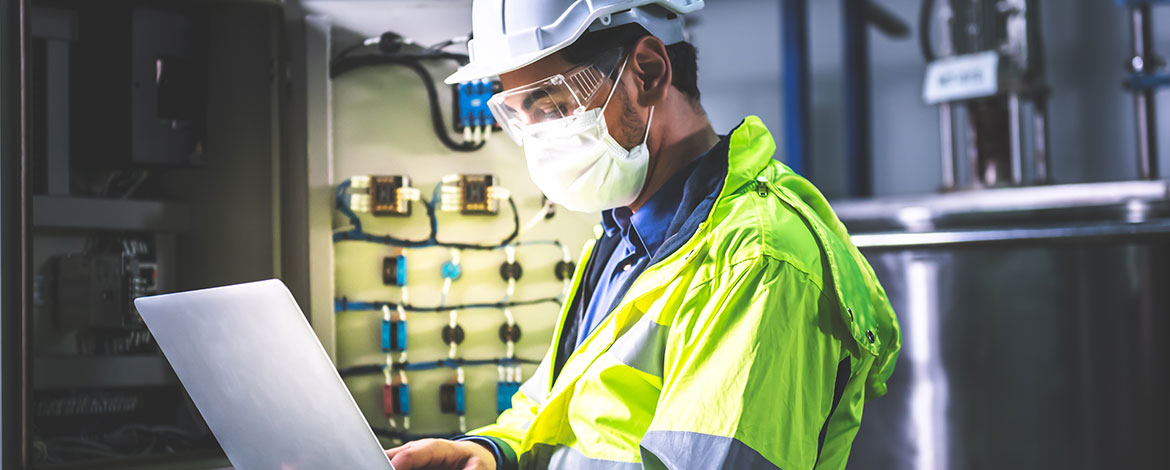
Managing and Planning
When the COVID-19 pandemic descended upon us so quickly in early 2020, nearly every restaurant was forced to part ways with some percentage of its workforce. Hiring back has been an enormous challenge, particularly as we continue to navigate consistently inconsistent rises and falls in COVID variants and their accompanying protocols and restrictions. Since many veteran restaurant workers have now transitioned to other industries, there is an inexperienced pool of applicants. The numbers are staggering:
- According to the Bureau of Labor Statistics, as of late 2021, restaurants were trying to fill 1.7 million jobs.
- 28% of operators believe it will take between 7 and 12 months to return to normal.
This is where a good CMMS platform can help.
In managing workload, a good CMMS allows you to ramp up quickly. It allows you to be in tune with your locations without having to be on-site. It maintains clear-cut processes for the benefit of veteran and new employees alike, keeping everyone on the same page and training much easier.
In the restaurant industry, things will go wrong; equipment will fail, facilities will break. A CMMS eliminates frantic questions of who should be called, where is the vendor’s contact info, how much must be allotted for that repair. By removing such concerns, your team can instead focus on running a successful restaurant and adapting to the new normal.
Another thing about this new, younger workforce: They are more “plugged-in” than any generation before. They’ve grown up surrounded by technology, and expect it to inform, guide, and assist them in everything they do. Their expectations at work will be no different, which is why you’ll want to increase operational efficiency and put actionable data and analytics at their fingertips. Train them, empower them, then allow them to focus on the guest experience that will be so vital in determining which restaurants continue to move forward.
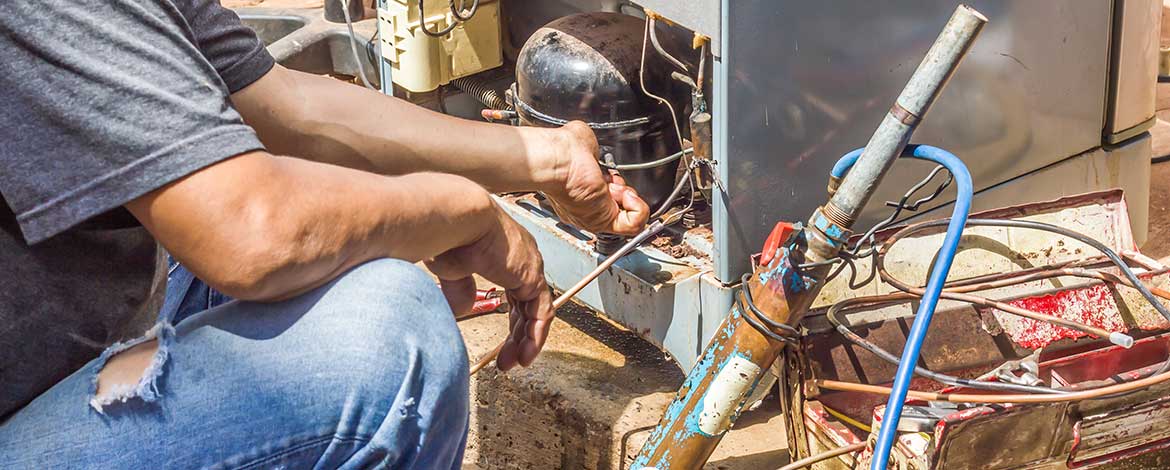
Real-time visibility
If we are to effectively manage this predominantly-new workforce, we’ll need more of a reliance on CMMS than ever. Heading into the pandemic, most restaurant concerns fell under the heading of penny-pinching, looking to see where they could trim the fat. These days, maintaining profits continues to be a concern. It has also been compounded by workforce worries, suddenly unavailable service providers, and other issues.
Let’s say it’s the dead of summer, 105 degrees outside, and your HVAC goes out. Now your guests are essentially sitting in a sauna, your kitchen is vulnerable, and you’re in danger of losing a day of revenue. It is crucial that whoever is addressing the problem is empowered to get ahold of the proper service provider, get them the information they need to come out, and have all the details they’ll need on the unit – its age, model number, maintenance history, and so on.
Questions abound, and you’ll have the answers: Is it time to repair or replace? What is the effectiveness of your contracted maintenance? Where are repair and maintenance dollars going, and why? With a CMMS like Ecotrak, a desktop interface and app allows you to streamline communication, reduce time on the phone, increase accuracy and get it all to the right vendor every time.
At a moment when you need streamlined facilities management to counter a reduced workforce, it’s more important than ever that you get things right the first time. A first-time fix helps minimize downtime, maintain that all-important relationship with your guests, and allow others to stay focused on front-of-house concerns. The next time they need a plumber, an electrician, or anyone else, all they need to do is open the app and with a few swipes, they can get the information and approvals they need to resolve a situation.
The CMMS platform then provides invoice statuses in real-time, so it’s simple to track costs, monitor spending, and ensure that your service provider has been paid. And you can bet that the service provider will remember your organization and promptness, so the next time that phone rings, they’ll pick up quickly.
Using data, you can reduce your repair and maintenance spending. You can improve vendor relations and sidestep equipment downtime. You can streamline your facilities management and navigate this tricky time of reduced workforces.
Responding to a crisis is one thing; preventing it is far better. A good CMMS solution is akin to having a psychic on your payroll, as it uses machine learning to analyze your data and automate the building of analytical models that predict when, where, and how soon your equipment will need to be repaired or replaced.

As we move past this pandemic, and the volume that comes back, your structure will be amplified. In other words, if you have a good structure and a solid CMMS solution in place and are well-deployed, you’ll be able to flex those strengths. If you don’t, your weaknesses will inevitably become your Achilles’ heel, leading to more wasted hours, wasted money, and wasted effort. Reducing spending and managing maintenance is the common goal of every restauranteur, and a good CMMS solution can position you to make sure that when we finally emerge from all this, you’ll be in control.
INDUSTRY INSIGHT
What's Happening at Ecotrak
According to the most recent numbers from the Bureau of Labor Statistics (BLS), there were 10.6 million job openings in November 2022 and 6.3 million unemployed workers. The difference between those numbers, around 4 million, indicates there are many more open positions than employee candidates across the economy.
Labor is top of mind for most facility operators at the moment, because it has become a significant operational issue for facility business models. Staffing challenges have led to operational disruptions, rising costs, and tighter profit margins.
The labor crunch won’t disappear overnight, so many operators are looking at diverse strategies to address the challenge. Your facility should be proactively implementing a labor strategy that approaches the issue from many different angles, from adopting creative hiring strategies to finding new efficiencies with facility management software tools.

Cost of the Labor Shortage
There isn’t one single reason causing the general staffing crunch, but a number of overlapping factors are related to the COVID-19 pandemic. Ripple effects from the pandemic continue to impact the economy, affecting everything from childcare availability to overall labor competition as industries hire heavily at the same time.
For your company, inadequate staffing undoubtedly has an impact on operations. Without enough employees, you may create a negative guest experience, be forced to cut operations or hours, and even potentially prompt a negative turnover feedback loop as existing staff face burnout.
High turnover rates have always created a large financial burden for operators, made all the heavier with the current labor market. The hiring process costs time and resources, and the disruptions to your team can hurt productivity, cause stress, and impact morale.
For most operators, fully staffing and reducing turnover are priorities. But with such complexities, where should your facility start?
For facilities professionals trying to navigate the labor shortage, there are three areas worth focusing on: hiring and retention, labor-saving facility data and analytics tools, and long-term investments.
Evaluating Hiring & Retention
At its core, facilities management is a people business. To address staffing, you should be investing in your people, from new employees to existing staff.
Always Be Hiring
In a competitive labor field, hiring should be a constant priority. While it may feel most urgent when you have a specific position to fill, consider listing “evergreen” job postings for your team to ensure you always have candidates in the pipeline.
As you invest in your hiring process, evaluate your system as a whole. Are candidates able to apply for positions, quickly and without a hassle? The more you can streamline the process for potential hires and your hiring managers, the better for your operations.
Offer Competitive Wages, Benefits, and Bonuses
With a tough hiring environment, your wages and benefits for your open roles should undoubtedly be competitive in the facilities industry. Make sure to list specific wage and benefit information in your job descriptions, rather than wait until the interview process, so that you communicate it clearly to potential applicants.
If you are considering expanding your benefits, use surveys or listening sessions with existing employees to understand their priorities. You may find that certain specific benefits, from childcare rebates and tuition reimbursement to a commute subsidy, stand out to your potential hires.
Finally, leveraging hiring bonuses as an incentive can help generate new applications. These bonuses should be paid out promptly after a strategic time period, such as three or six months, to encourage new hires to stick through the initial training period and become engaged with the company.
Invest in Employee Retention
While you may need to focus on hiring, don’t lose sight of the valuable staff you already have on your team. Retaining employees is generally healthier for your bottom line than hiring new ones.
Using the above example, if you are offering hiring bonuses, consider implementing retention bonuses to recognize valuable long-time employees as well (which also shows your new hires that your company prioritizes staff appreciation).
In addition, while wages and benefits certainly are important to employees, many staff members also care deeply about their big-picture career opportunities. Investing in employees is a critical retention strategy, covering programs from training and employee development to prioritizing promoting from within the company.
Make the Most Out of Facility Operational Spend
For many facility operators, investing in technology and automation can help counteract rising labor costs. If you are struggling to hire enough staff, you may want to consider investing capital in other places, like automating time-consuming processes and reporting.
Streamline Scheduled Labor Costs
Your labor data can help you find how to best streamline your labor spend, without negatively impacting employee retention or guest satisfaction.
Sales forecasting uses historical sales data and current market conditions to project sales in comparable time periods. Sales forecasting empowers your scheduling managers to make schedules based on data, rather than “what we always do” guesses.
Your data can also showcase trends and help you refine labor costs over time. Granular info like labor spend by day part or by role can allow you to evaluate where tweaks are needed based on labor cost as a percentage of sales goals.
Look for Operational Efficiencies
Facilities management requires tracking many moving pieces and completing repetitive tasks. The more operational efficiencies you add in through all-in-one facility management software, the more you can streamline labor costs.
For instance, mobile-first facilities management technology can add time savings for your staff. Not only can you place service requests on the go, you can also increase accuracy by including photos, videos and manuals to work orders. With approvals, proposals, and invoices accessible via mobile, your team can find new efficiencies in their workload without adding new labor costs.
Facilities data and analytics software can add in other efficiencies in areas like equipment status tracking. A central dashboard can track real-time equipment costs, repair and maintenance costs, and warranty info. By proactively staying on top of the equipment life cycle, your staff can easily calculate whether to repair or replace without a time-consuming (and uncertain) manual process.
Automate Wherever Possible
Finally, using facilities management software to automate operations creates direct labor efficiencies and also improves the accuracy and relevance of your equipment data.
As an example, automation can help streamline work order management, building a smooth system for creating, assigning, and tracking work orders. Managers can be prompted through customized workflows to quickly approve work orders and invoices. Facilities software can also automate equipment warranty monitoring, even diving down to varying levels of manufacturer, service provider, and component part warranties.
Overall, automation can streamline staff responsibilities, using custom workflows to remind key staff about scheduling preventive equipment maintenance services, reducing downtime and increasing equipment lifespan.
Addressing Labor in the Long-Term
While some components of your labor strategy are urgent in the short-term, there are also big-picture priorities across your facility to consider in your strategy.
Prioritize Continuity in Operations
Although it isn’t ideal, operators should be preparing to potentially experience elevated levels of turnover for an extended period of time. To ensure minimal disruptions, make sure to plan for continuity in your operations.
Your technology tools are a central part of this strategy. A Computerized Maintenance Management Systems (CMMS) can ensure your team is tracking facilities spend, assets, and warranties in one central, secure location. No matter any turnover, this data is searchable and accessible.
With the right facilities management software, staff and leadership can get a complete understanding of facility spend and service history, broken down into asset, location, or repair type. A centralized, up-to-date database is key to absorb any potential turnover disruptions in your team.
Involve Leadership in Strategy
Finally, with the current labor market, staffing is no longer a concern just for the facilities-level managers. Addressing the labor shortage should be considered a major operational priority for facilities leaders, from the location-level all the way up to company leadership. Just as leadership and management set the tone for a healthy culture, the team is also able to influence the overall labor approach.
From the C-Suite throughout the rest of the organization, consider making hiring, retention, and staffing a visible priority and resource appropriately. Leadership can direct investment to new hiring and retention initiatives, or take the lead in supporting the shift to new facilities management software tools and solutions.

Find Success in a Challenging Labor Market
There are many different strategies to address today’s labor challenges. But with a focus on staffing efforts, technology efficiencies, and long-term thinking, your facility can turn these challenges into more streamlined, efficient operations and a thriving team culture.
If you are exploring how facility management software can help your company navigate today’s challenges, consider exploring a facility management software solution such as Ecotrak. Using a Computerized Maintenance Management Systems (CMMS) can empower your staff to thrive and help you add new automations and efficiencies into your facilities operations.
Request a demo of Ecotrak today.
INDUSTRY INSIGHT
What's Happening at Ecotrak
It happens at home, just like it happens on the job. You take the time to research appliances, shop around for the best rate, set up your kitchen just the way you like — all in time for something to break down without warning. But while at home you might be able to scrape by without a stovetop for a few days, when it comes to work, inability to function means inability to serve, which means inability to open your doors.
Asset lifecycle management brings predictability to the unpredictable. It allows you to maximize your investment, minimize time spent grappling with adversity, and utilizes the latest in metrics and data analysis to help you learn how you can get even more value out of your appliances.
If you have a good asset lifecycle management plan in place, the three factors listed below are friendly, not fearsome. If you don’t, well, you’re operating like a chef with both hands tied behind his back.
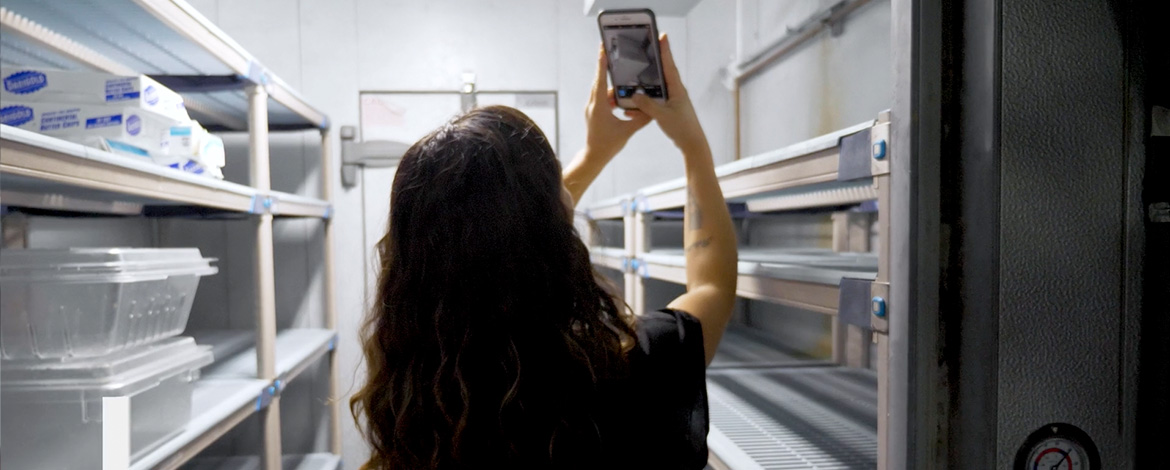
Knowing what the future holds
Every asset has a natural, four-stage lifecycle: Planning, Procurement, Operation/Maintenance and Disposal. Whether your restaurant’s kitchen is shiny and new, or you’re acquiring equipment that already has a few years on the odometer, each item is at some stage of this lifecycle.
If you’re in the early days of a small operation, you might be able to keep track in your head of what’s new, what’s old, and what’s being held together with duct tape. But when your business becomes multiple locations, with multiple kitchens, and you’re making significant investments in ovens, deep fryers, refrigeration, beverage dispensers and more, it can very quickly overwhelm any facilities management team.
A smart business has the foresight to consider the entire lifecycle before even moving beyond the planning phase. As you’re researching manufactures and considering which model is right for your needs, you should also be analyzing likely maintenance costs, the average lifespan of the asset, and what kind of daily wear-and-tear it will endure in your kitchen. As you move into procurement, it’s vital that you activate and track all warranties, have serial numbers and model identifiers at the ready, and that each asset is installed and powered properly. Then, as you move into the operation and maintenance stage, issues can be overcome quickly and efficiently — with information at your fingertips that will prevent duplicate service calls and costly ignorance of the asset’s warranty eligibility.
By predicting when an asset will reach its optimal peak performance and leaning into that window, you can calculate its depreciation value, ensure compliance with regulatory standards and most importantly, keep your business up and running.
Planning a repair and replacement budget
Unfortunately, breakdowns are every bit as unavoidable as death and taxes. At that point, a key question presents itself: Is it worthwhile to repair the asset? Or is it time for disposal and replacement?
This is one moment where, if you have good asset management software to back you up, you’ll be empowered to turn a crucial decision into an educated one. For starters, every breakdown is a learning opportunity. A CMMS platform should compile and analyze them, across all your locations, so you can answer questions like: What’s my most commonly-occurring problem? What’s my most expensive problem? Is one manufacturer brand outperforming another?
If you have Ecotrak as your facilities management software solution, it’s simply a matter of any authorized person in your company taking out their phone, opening the app and looking under Ecotrak’s proprietary “Decision Making Tool,” designed by restaurant and finance veterans with such a moment in mind. The tool displays personalized details about your asset, its original value and likely cost of a replacement. It also offers an estimated useful window of service (based on the hive-mind experiences of other users) and reminds you where yours is in that likely lifespan.
The “Decision Making Tool" or DMT — whose icon is a weight-balance scale, to underscore the plus/minus decision being weighed — then gives you a likely estimate for your repair, shows you how much you’ve spent already over the lifetime of the appliance, and offers an easy-to-read gauge system to make the choice even more transparent. If the needle is in the red, it’s likely time to replace; if you’re in the green, a repair is the more reasonable choice. But perhaps most helpful is the small yellow section, indicating that while you’re safe for now, it would be wise to begin setting aside funds for a replacement in the near future.
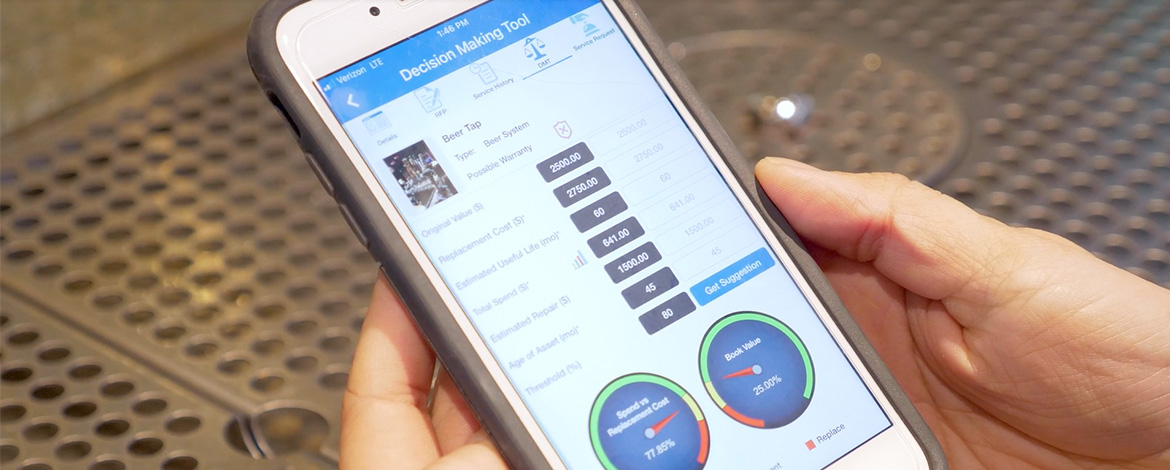
Facility management dependence
Whether you have dozens of locations, or simply dream of getting there someday, it is crucial that you monitor the lifecycles of your assets.
Ecotrak maintains information specific to the asset, then makes it available to both the customer and the service provider, enabling a smoother interaction. From manufacturer to model to serial number, to the ability to track warranties on three different levels (manufacturer, service provider and the often-overlooked component warranties), to documentation and saved photos of the actual equipment, everything is available on the app with a few swipes of a finger.
Another great tool is the custom flagging feature. Imagine if you or your management team could run a report for a designation such as “earmarked for replacement,” immediately pulling up every asset in your company approaching that final stage of the lifecycle. Keep in mind, this is real time information, provided up-to-the-minute by those you have designated at various locations. If a manager came in to find a broken dishwasher during the morning shift today, that could be on your report. This flag feature allows you to build your budget, anticipate work to come, and increase visibility and communication — and keep in mind, you can make as many flags as you need for subheadings like “inspection needed,” “ready to be cleaned” and more.
All this asset lifecycle information, of course, informs your company’s facility management efforts, and vice versa. With a company like Ecotrak, it’s all under one convenient umbrella, constantly updating data that you can view, adjust and share from your mobile device or desktop. So, if you want to see the problems costing the most money across your company, or the ones occurring most frequently, you can do so with precision; if you’d like to view your company’s spend by asset (who knew that maintaining the soft serve machine and grease trap costs as much as the HVAC?), or monitor which vendors are taking the most average days to complete a work order, all that information is similarly up-to-the-minute and ready for a deep-dive analysis.
The bottom line
When it comes to asset lifecycle management, you can either be driving the train or, if you’re not careful, get run over by it. Imagine all the considerations listed above, multiplied by a dozen locations — or a hundred, or a thousand. Whether you’re talking about Del Taco managing 300 corporate locations with their Ecotrak software, or other existing partners like Outback, Burger King and Lazy Dog, it’s easy to see why a software solution for overseeing your assets is a no-brainer.
INDUSTRY INSIGHT
What's Happening at Ecotrak
Meredith Sandland and Carl Orsbourn, food industry leaders, are the co-authors of the new book Delivering the Digital Restaurant: Your Roadmap to the Future of Food.
Focusing on the rise of off-premise business and digital interfaces in the restaurant industry, their insights will resonate with facilities managers and any restaurateur looking to navigate the new normal.
How is automation and technology transforming facilities management and off-premise businesses? Here are some of the key takeaways from the book, available now at www.deliveringthedigitalrestaurant.com (use ECO25 for Ecotrack’s exclusive 25% discount).
Focusing on customer-centric & off-premise business
According to Delivering, the COVID-19 pandemic only accelerated disruptive trends that were already in motion. Restaurants now need to “shift how they think, behave, and invest to survive and thrive” to keep up with today’s consumer.
Consumers are demanding from restaurants what they’ve already been demanding from retail: quality and convenience, when and where they want it. Restaurants that can provide good quality food, with a frictionless, on-demand interaction, will be able to capitalize on new opportunities.
While some restaurants want to “return to normal,” Delivering argues that the baseline has fundamentally changed and is requiring new investments in technology. “The change in the consumer is creating the reason for technological investments to be made, not the other way around,” said co-author Meredith Sandland.
“The customer is now the center of your technological universe,” added Carl Orsbourn, co-author. “You need to make your decisions based around how to improve the consumer journey and your own engagement with the consumer. This means using data.”

Transforming the industry because “digital is not optional”
According to Delivering, “running a successful restaurant in the 21st century requires not just great food and great service—it also demands an understanding and application of technology.”
Sandland admitted the challenge of incorporating technology into business is difficult. She gave the example of a small chain restaurateur reporting that he received at least 10 emails or phone calls a day from companies trying to sell software and tech services, and he struggled to find the one that matched his restaurant needs. “The number of new technology solutions out there is so high, it can be completely overwhelming,” she acknowledged.
But while it may be a challenge, Sandland strongly advocated that technology offers a better way to operate a restaurant.
As the former Chief Development Officer for Taco Bell, she has deep experience with facility management. To streamline the time-consuming nature of maintaining and repairing equipment, the maintenance team used custom in-house software years before such things were widely available. These in-house solutions “allowed us to add efficiencies that other, smaller restaurant chains couldn’t access” while tracking service tickets and preventative maintenance.
“Before, it took a giant company like Yum! Brands [parent company of Taco Bell], with a huge balance sheet, to build these incredible technologies that only they could have. They needed a scale of all their restaurants to really have it make sense,” Sandland said.
“The new ‘SaaS-ification’ of technology is remarkable,” she continued. As software as a service (SaaS) companies grow offerings for technology and automation, smaller restaurant companies now have access to the same innovative software that can transform operations.
“Now, anyone can get these things for a monthly fee. I think it levels the playing field between the really big restaurant companies and the smaller ones,” she added.
Automating as much as possible
Now that efficient technology and software is available to restaurants, Sandland and Orsbourn advocate for facilities to take advantage of it as much as possible, particularly through automation.
Sandland explained that restaurant managers are responsible for a dizzying array of tasks, from HR to facilities to food and customer service. “If you can automate with software as much as possible, so that the heavy lifting is being done in a replicable and scalable way—I think it's critical for an operation to run effectively,” she explained.
Investing in automation can benefit restaurants particularly as labor costs continue to rise. Adding in new layers like remote management, or automation that increases speed of off-premise order aggregation and fulfillment, allows restaurants to cope with new challenges.
While it can be time-consuming at first, Orsbourn recommended following your own “technology road map” to understand what tech you need, when. How you implement automation, he said, depends on “where you are in your journey towards digital maturity”. The co-authors recommended starting by examining where there may be a cost problem, top line issue, or a bottleneck in tasks.

Leveraging scale in off-premise opportunities like ghost kitchens
Delivering the Digital Restaurant also discusses the rise of ghost kitchens, restaurants that sell food without a front-of-house brand presence. These facilities may house multiple concepts within the same space, providing new efficiencies for utilities, labor, supply chain, and building costs.
Opportunities of scale can provide enormous benefits for facility management, said the co-authors. For example, for facilities that struggle to get out of a loop of reactive maintenance, ghost kitchens provide an opportunity to get ahead of preventative maintenance. With a density of restaurants in one location, said Sandland, “you can set up relationships with vendors to come in and do preventative maintenance in a way that's much more scalable for the vendor—and potentially get a discount on that as a result.”
The density also provides opportunities of scale for technology solutions as well. With the consumer demand for speed in off-premise sales and delivery, “that sets up a whole world of automation that can come in and make that process more efficient” in ways that might not apply to a smaller restaurant, added Sandland.
Increasing efficiency in facility management with new technology solutions
Facilities managers are at the forefront of using technology in a customer-centric, off-premise world. Sandland and Orsbourn highlighted multiple areas for facilities management professionals to focus on.
For example, Sandland explained that as consumers come back to dine-in, being up-to-date with repairs for items that consumers can see, touch, and feel is critical to a positive customer journey. While this may not have been a priority for facilities in the past year of minimal in-house sales, now, said Sandland, “if customers see things in front-of-house that are broken, they start to wonder what’s going on in the back-of-house.”
Orsbourn highlighted the need to prioritize building trust with consumers. The “open kitchen” model had been popularized in recent years, so customers could see their food being prepared. Now, in a world of food delivery and ghost kitchens, “all of that is hidden away,” said Orsbourn. The possibility of eventual trust or disconnection issues makes maintaining facilities and any customer-facing facilities more critical than ever.
Technology is also helpful for “monitoring kitchen usage as efficiently as possible”, said the co-authors.
Orsbourn shared that as “virtual brands” in ghost kitchens start to share spaces, “slightly movable pieces of equipment can help virtual brands in a more effective way” through an adjustable kitchen configuration. “I think there will be ways in which facilities managers are going to have to be able to understand the modularity of the kitchen to accommodate that,” he added.
Orsbourn also highlighted the major development of these off-premise kitchens: while restaurant revenue used to be limited by number of tables and turn times, for a model like a ghost kitchen, the limiting factor is actually the maximum throughput capacity of a kitchen.
“If I did have an infinite amount of tables out there, how many dishes could I truly push out through this kitchen? And what would I need to do to make that happen?” he said. Facility management is primed to take center stage as restaurants consider investing more in remodeling back-of-house instead of front-of-house.
Sandland agreed, adding, “I think there will be a lot more attention turned to the back of the house. How is it set up? What equipment is in it? What needs to be replaced? What should be more efficient? What should be more automated? The facilities management team typically gets to implement those decisions.”
Conclusion
As these developments take over the industry, it is clear that automation and other smart solutions in facilities management are more important than ever.
Interested in learning more takeaways from Delivering the Digital Restaurant: Your Roadmap to the Future of Food? Grab a copy of the book to learn more from Carl Orsbourn and Meredith Sandland’s industry insights (go to www.deliveringthedigitalrestaurant.com and use code ECO25 for a 25% discount and free shipping).
And if you are thinking about how facility management software can help your facility or ghost kitchen thrive in this new technology-driven world, consider exploring a facility management software solution such as Ecotrak. Using a Computerized Maintenance Management Systems (CMMS) can help you track equipment in ghost kitchens and other off-premise businesses to thrive in today’s new restaurant industry.
INDUSTRY INSIGHT
What's Happening at Ecotrak
When you joined the restaurant industry, you wanted to nourish people’s hearts, souls and stomachs. You likely dreamed of helping create a gathering place where co-workers could get together for a happy hour, families could celebrate a birthday, or friends could catch up over appetizers. The last thing you wanted to deal with was work orders, broken equipment and invoicing. Which is where facility management software comes into focus.
A competent software solution provides invaluable infrastructure to a business, allowing many daily headaches to be eased by a streamlined, proven system; a poor choice, however, could just compound those headaches. With that in mind, let’s take a look at what facility management software is, and how it can help you get back to the things you really care about.
Facility management software also called a computerized maintenance management system (CMMS) is a software that maintains a database of information about an organization’s assets, repair and maintenance operations. Businesses can place services requests, manage workorders, communicate with vendors and analyze data from a dashboard, thus helping facilities managers (FMs) do their jobs more effectively.
The benefits of good facility management software can be broken down into three categories. In some ways, each feed off the other; in a perfect world, they serve your business like a good insurance policy — operating quietly in the background, while giving you piece of mind.

1. Data analysis
Robust, customizable reporting empowers you to make more educated business decisions. Viewing your spend data by such variables as equipment type, location and manufacturer affords greater insight into what’s costing you money and why.
Years ago, such data was mostly anecdotal, and most analysis had to be based on gut feelings. The more locations your restaurant opened, the more difficult it became to spot trends, know which equipment was giving you the best bang for your buck, and adjust plans accordingly. Today, if you properly track your facility management issues, it’s so much more than simply getting a grill fixed.
Every time a new piece of equipment enters one of your locations, you take a few moments to share information about its make, model, purchase date, warranty and other such details. A good facility management system will take it from there — no matter how big you get, no matter how much equipment you need to track.
When equipment breaks, rather than picking up the phone, texting, emailing or searching online for who to call, you simply place your request through a solution like Ecotrak; information is extrapolated from your original registration, a work order is created, and you get updated every step of the way as the equipment is repaired — even allowing the service provider to invoice you, and integrating with your own accounting software if you so choose.
When you have your spending monitored and your profit & loss performance maximized, that eliminates guess work and allows you to manage your operations much more effectively. It also empowers you on the fly to ask and answer questions like:
“What’s my most expensive problem?”
“Is one manufacturer brand doing better than another?”
“Is there a model within that brand that might be outperforming another model?”
A good facility management solution will provide immediate answers to these and other questions in easy-to-understand, highly-interactive graphs and models that bring you the next-level facility management data and analytics a growing business requires. By staying ahead of your asset’s needs, you can maximize its lifespan and minimize energy consumption — both important factors in sustainability. A good facility management solution also automates industry, state and federal regulations that require documentation of work and compliance.
Imagine having such information at your fingertips, and how it could assist you in making educated, data-driven decisions for your business.
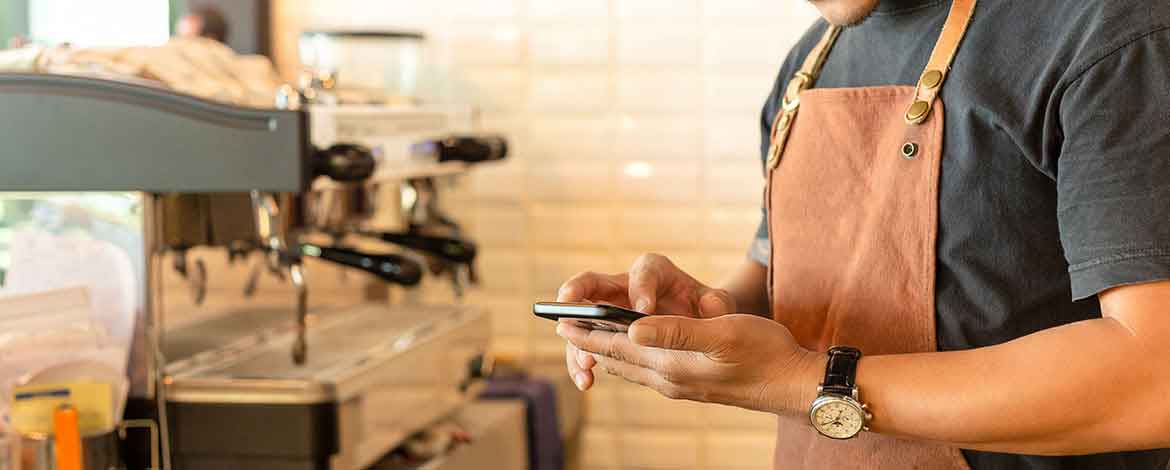
2. Increasing Efficiency
If you aren’t actively tracking your refrigerant use and considering ways to redirect spending towards greener products, you aren’t doing your best to reduce carbon emissions, provide a healthy and clean environment for customers and employees, and save money on energy costs and compliance. If your aren’t budgeting for futures breakdowns and replacements based on past breakdowns and replacements, you aren’t properly budgeting and anticipating work to come.
Good facility management software gives you a wider overview. The ability to manage vendors, receive proposals, request service, handle invoices or approve work orders should be at your fingertips, using cutting-edge technologies and easy-to-navigate mobile apps designed with the operator in mind. A good facility management solution will give you this information in real time, allowing you to instantly see the status of every work order and the service history of every product, as well as its cost.
Typically, it also empowers those around you, allowing you to focus your time and energy elsewhere. If a manager at a location in another state comes in tomorrow morning to find a misbehaving refrigerator, as long as they are authorized, proper servicing is at their fingertips. When they submit a service request, you can set yourself and others up for approvals — and redundant requests are rooted out, eliminating the cost of mistaken visits from double-booked service providers. So when the next manager comes in for the night shift and encounters the same problematic refrigerator, their service request would result in an alert that the problem is already being addressed.
A system like Ecotrak — designed by people with a long history the restaurant and hospitality industry— provides an app that allows the user to execute such service requests in moments, as well as approving work orders and invoices with a swipe of the finger. It’s also a communication tool, enabling not only messages with service providers, but also a reviewable record of such communications. The app’s clear interface empowers the user by displaying the estimated life of equipment, its current age, and spend vs. replacement costs.
It takes about 30 seconds to find your restaurant location, select your problematic piece of equipment, type what’s wrong and if you’d like, upload pictures. At that point, you hit “submit” and can go back to work, knowing the ball is rolling.
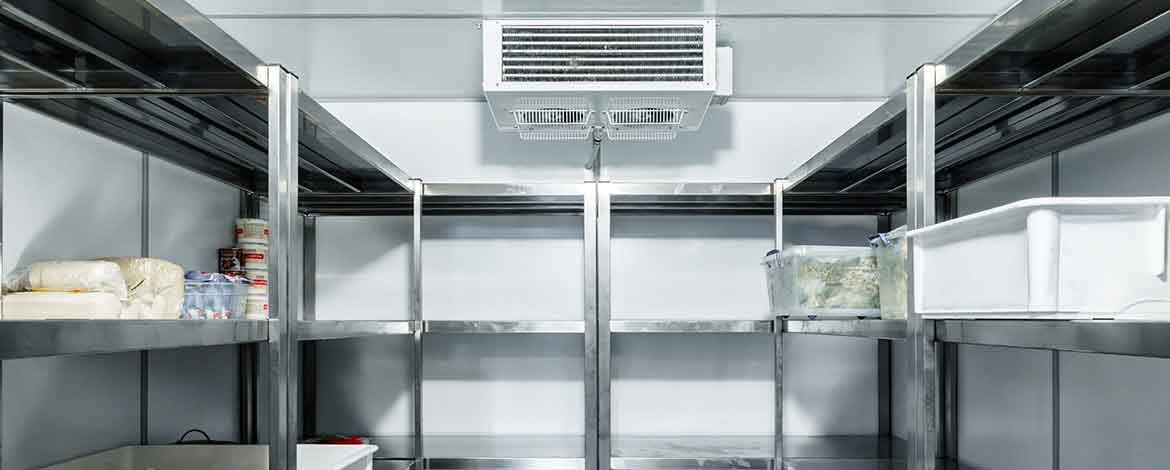
3. Saving money
On average, Ecotrak users find that warranty, call aversion and troubleshooting savings result in a 5 percent reduction in maintenance spending, one that typically has the software paying for itself in about six months.
Working with such industry-leading brands as Applebee’s, Fresh Brothers, Lazy Dog, Burger King and Buffalo Wild Wings, Ecotrak facility management software is constantly updated with cutting-edge industry advancements and insights, bringing users the latest ways to track their spending. Some have a handful of locations and big plans to grow; others use Ecotrak across thousands of locations.
Taking a unique, asset-first approach, Ecotrak tracks all things related to facilities and assets, giving you a snapshot of not only what you’re spending but where the money is going, what it’s being spent on and with which vendors. This results in a starting point to drive cost-saving initiatives and cost-reduction initiatives while gaining valuable insight.
There are 3 ways the company saves its restaurant operators money: Tracking warranties (and making that information available to both the operator and the service provider), spotting duplicate service requests (eliminating redundant service call charges), and troubleshooting. On average, Ecotrak customers save 5 percent on their repair and maintenance spend, empowered by AI-driven technology that allows them to manage spending, improve capital planning and better forecast the future.
The Ecotrak desktop interface has the same functionality as the mobile app, but adds in summary information and increased settings flexibility. All told, information is power, and a good facility management solution empowers you with granular data, viewed in a wide, flexible array of options.

